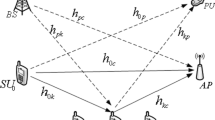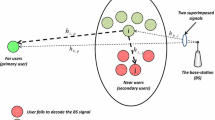Abstract
In multi-user cooperative cognitive network, the primary user and cognitive user can not share the same spectrum band simultaneously, which leads to low spectrum utilization. Based on this fact, a distributed interference alignment algorithm based on a relay is proposed. This algorithm considers cognitive user as a relay, which means it transmits both its own transmitting signal and the primary user’s transmitting signal. At receivers, they can separate their desired signals without interference. The primary link does not need to perceive the existence of cognitive link. The proposed algorithm makes the complexity of pre-coding low. Its process of pre-coding is implemented by the relay. In addition, analysis and simulation results show that the channel capacities of primary and cognitive link are all improved compared with those of traditional algorithms in both strong and weak correlation channel conditions.




Similar content being viewed by others
References
Amir M, Ei-Keyi A, Nafie M (2011) Constrained interference alignment and the spatial degrees of freedom of MIMO cognitive networks. IEEE Trans Inf Theory 57(5):2994–3004
An Y, Xiao Y, Qu G (2012) Multi-band spectrum auction framework based on location information in cognitive radio networks. J Syst Eng Electron 23(5):671–678
Zhao N, Yu FR, Leung VCM (2015) Opportunistic communications in interference alignment networks with wireless power transfer. IEEE Wirel Commun 22(5):88–95
Gomadam K, Cadambe VR, Jafar SA (2011) A distributed numerical approach to interference alignment and applications to wireless interference networks. IEEE Trans Inf Theory 57(6):339–3322
Ayach OE, Peters SW, Heath RW (2013) The practical challenges of interference alignment. IEEE Wirel Commun 20(1):35–42
Rezaei F, Tadaion A (2014) Interference alignment in cognitive radio networks. IET Commun 8(10):1769–1777
Jeon S-W, Suh C (2016) Degrees of freedom of uplink–downlink multiantenna cellular networks. IEEE Trans Inf Theory 62(8):4589–4603
Lee JH, Park D (2012) Antenna selection and unitary precoding for interference alignment with ML receiver. IEEE Commun Lett 16(8):1216–1219
Nguyen DN, Krunz M (2013) Cooperative MIMO in wireless networks: recent developments and challenges. IEEE Netw 27(4):48–54
Zhao N, Yu FR, Sun H, Li M (2016) Adaptive power allocation schemes for spectrum sharing in interference alignment (IA)-based cognitive radio networks. IEEE Trans Veh Technol 65(5):3700–3714
Cong S, Michael PF (2011) Opportunistic spatial orthogonalization and its application in fading cognitive radio networks. IEEE J Sel Top Signal Process 5(1):182–189
Guler B, Yener A (2014) Selective interference alignment for MIMO cognitive femtocell networks. IEEE J Sel Areas Commun 32(3):439–450
Jeon S-W, Kim K, Yang J, Kim DK (2017) The feasibility of interference alignment for MIMO interfering broadcast–multiple-access channels. IEEE Trans Wirel Commun 16(7):4614–4625
Mosleh S, Abouei J, Aghabozorgi MR (2014) Distributed opportunistic interference alignment using threshold-based beamforming in MIMO overlay cognitive radio. IEEE Trans Veh Technol 63(8):3783–3793
de Kerret P, Gesbert D (2014) Interference alignment with incomplete CSIT sharing. IEEE Trans Wirel Commun 13(5):2563–2573
Morales-Céspedes M, Plata-Chaves J, Toumpakaris D, Jafar SA, Armada AG (2017) Cognitive blind interference alignment for macro-femto networks. IEEE Trans Signal Process 65(19):5121–5136
Yang HJ, Shin W-Y, Jung BC, Paulraj A (2013) Opportunistic interference alignment for MIMO interfering multiple-access channels. IEEE Trans Wirel Commun 12(5):2180–2192
Yuan B, Liao X, Gao F, Luo X (2014) Achievable degrees of freedom of the four-user MIMO Y channel. IEEE Commun Lett 18(1):6–9
Zhao N, Yu FR, Leung VCM (2015) Opportunistic communications in interference alignment networks with wireless power transfer. IEEE Wirel Commun 22(1):88–95
Zhao N, Yu FR, Jin M, Yan Q, Leung VCM (2016) Interference alignment and its applications: a survey, research issues, and challenges. IEEE Commun Surv Tutor 18(3):1779–1803
Acknowledgements
This project is supported by ‘The Excellent Going Abroad Experts’ Training Program in Hebei Province, Doctoral Research Start-up Fund of North China University of Science and Technology, Hebei, Natural Science Foundation of China (No. F2014209276).
Author information
Authors and Affiliations
Corresponding author
Rights and permissions
About this article
Cite this article
An, Y., Sun, R., Wu, X. et al. Distributed interference alignment algorithm in downlink multi-user cooperative networks. J Supercomput 75, 2058–2069 (2019). https://doi.org/10.1007/s11227-018-2580-6
Published:
Issue Date:
DOI: https://doi.org/10.1007/s11227-018-2580-6




